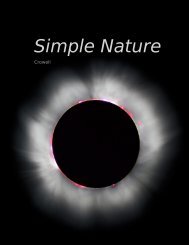The size of a radio antenna is closely related to ... - Light and Matter
The size of a radio antenna is closely related to ... - Light and Matter
The size of a radio antenna is closely related to ... - Light and Matter
You also want an ePaper? Increase the reach of your titles
YUMPU automatically turns print PDFs into web optimized ePapers that Google loves.
s / St<strong>and</strong>ing waves on a rope. (PSSC Physics.)<br />
t / Surpr<strong>is</strong>ingly, sound waves<br />
undergo partial reflection at the<br />
open ends <strong>of</strong> tubes as well as<br />
closed ones.<br />
u / Graphs <strong>of</strong> excess density<br />
versus position for the lowestfrequency<br />
st<strong>and</strong>ing waves <strong>of</strong><br />
three types <strong>of</strong> air columns. Points<br />
on the ax<strong>is</strong> have normal air<br />
density.<br />
St<strong>and</strong>ing wave patterns are rather important, since a<strong>to</strong>ms are<br />
really st<strong>and</strong>ing-wave patterns <strong>of</strong> electron waves. You are a st<strong>and</strong>ing<br />
wave!<br />
St<strong>and</strong>ing-wave patterns <strong>of</strong> air columns<br />
<strong>The</strong> air column inside a wind instrument behaves very much<br />
like the wave-on-a-string example we’ve been concentrating on so<br />
far, the main difference being that we may have either inverting or<br />
noninverting reflections at the ends.<br />
Some organ pipes are closed at both ends. <strong>The</strong> speed <strong>of</strong> sound<br />
<strong>is</strong> different in metal than in air, so there <strong>is</strong> a strong reflection at<br />
the closed ends, <strong>and</strong> we can have st<strong>and</strong>ing waves. <strong>The</strong>se reflections<br />
are both density-noninverting, so we get symmetric st<strong>and</strong>ing-wave<br />
patterns, such as the one shown in figure u/1.<br />
Figure t shows the sound waves in <strong>and</strong> around a bamboo Japanese<br />
flute called a shakuhachi, which <strong>is</strong> open at both ends <strong>of</strong> the air column.<br />
We can only have a st<strong>and</strong>ing wave pattern if there are reflections<br />
at the ends, but that <strong>is</strong> very counterintuitive — why <strong>is</strong><br />
there any reflection at all, if the sound wave <strong>is</strong> free <strong>to</strong> emerge in<strong>to</strong><br />
open space, <strong>and</strong> there <strong>is</strong> no change in medium? Recall the reason<br />
why we got reflections at a change in medium: because the wavelength<br />
changes, so the wave has <strong>to</strong> readjust itself from one pattern<br />
<strong>to</strong> another, <strong>and</strong> the only way it can do that without developing a<br />
kink <strong>is</strong> if there <strong>is</strong> a reflection. Something similar <strong>is</strong> happening here.<br />
374 Chapter 6 Waves














